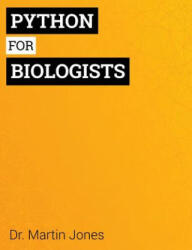Python for Biologists: A Complete Programming Course for Beginners (ISBN: 9781492346135)
Python for Biologists: A Complete Programming Course for Beginners (ISBN: 9781492346135)
Oferte pentru produsul Python for Biologists: A Complete Programming Course for Beginners (ISBN: 9781492346135)
Ofertele pentru produsul
Garantie Cumparare
Cumpara direct de pe Compari.ro fara probleme!
Serviciul nostru Garantie de achizitie se aplica tuturor comenzilor plasate direct prin intermediul site-ului Compari.ro prin accesarea butonului „Cumpara”.
Credem ca cumparaturile cu noi sunt fara probleme, asa ca nu ne este frica sa garantam acest lucru.
-

90 de zile returnarea produsului
Produsul a carui ambalaj este nedeteriorat si nedeschis poate fi returnat in termen de 90 de zile, iar comerciantul va rambursa pretul produsului. -

Pret garantat
Va garantam ca nu exista costuri ascunse. Veti primi produsul la pretul la care l-am confirmat. -

Banii Dvs. sunt in siguranta
Daca cumparati prin Compari.ro, nu va veti pierde banii. Daca produsul comandat nu ajunge, va vom rambursa suma achitata si vom prelua administrarea ulterioara cu magazinul online partener. -

Fara probleme cu produsul comandat
Daca primiti un produs deteriorat sau altul decat cel pe care l-ati comandat, va vom ajuta sa rezolvati situatia creata cu comerciantul si va vom despagubi orice daune cauzate. -

Nu exista intrebari fara raspuns
Va vom ajuta sa comunicati cu comerciantul. Ne poti contacta oricand cu intrebarile Dvs, iar in cazul unei reclamatii va vom ajuta sa o solutionati

Cumparati direct de pe Compari.ro
Accesand butonul „Cumpara”, puteti comanda produsul selectat prin Compari.ro fara a fi nevoie sa faceti clic catre magazinul respectiv, simplificand astfel procesul de cumparaturi online.
-

Cumparaturile cu noi sunt garantate fara probleme
Retur de produs in 90 de zile pentru produsul nedeschis. Daca primiti un produs deteriorat sau un alt produs decat cel pe care l-ati comandat, va vom ajuta sa rezolvati situatia creata cu comerciantul si va vom despagubi orice daune cauzate. -

De la cine comandati?
Compari.ro are rol de intermediar in vanzarea produselor date: produsele achizitionate de pe site nu sunt distribuite de Compari.ro, ele sunt vandute utilizatorilor nostri de catre magazinul online partener de langa oferta de produs selectata. Ca urmare, magazinul online care comercializeaza produsele, furnizeaza informatii clientilor cu privire la conditiile de livrare, facturare si garantie ale produsului. -

Ce metode de plata si preluare sunt disponibile?
Puteti achita cu card bancar, prin transfer bancar sau personal la preluare. Puteti comanda produsul cu livrare la domiciliu la un punct de livrare, dar il puteti ridica si personal.

Caracteristici, descrierea produsului - Python for Biologists: A Complete Programming Course for Beginners (ISBN: 9781492346135)
| Genul | Limbi străine, Tehnică de calcul |
Descriere detaliată Python for Biologists: A Complete Programming Course for Beginners (ISBN: 9781492346135) »
| Genul | Limbi străine, Tehnică de calcul |
Ați găsit greşeli în descrierea produsului? Vă rugăm să ne trimiteți o notificare!
Prețurile și informațiile de pe paginile noastre sunt furnizate de magazinele partenere și au caracter informativ, unele erori pot apărea. Imaginile produselor au caracter informativ, uneori pot include niște accesorii care nu sunt mereu incluse în pachetul de baza. Informațiile aferente produsului (imagine, descriere, preț) se pot schimba fără notificare prealabilă. Compari.ro nu își asumă responsabilitate pentru eventualele greșeli.

